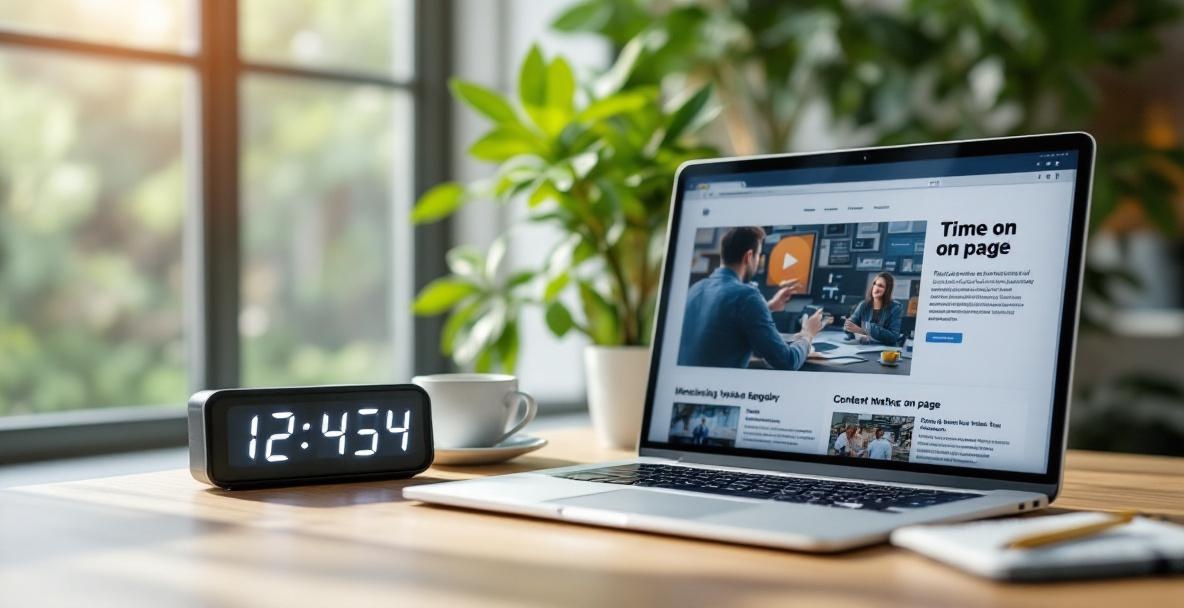Why Your Visitors' Time on Your Page Really Counts

“Time on page is widely recognized as a key metric for measuring content effectiveness and user engagement.”
Ever notice when someone lands on your website and leaves almost immediately? It can feel like all your effort goes unnoticed even if your site looks sharp and your copy is solid. At SeoFlow, we’ve learned that time on page isn’t just a number-it shows whether your message connects with your visitors. This measure tells you if people find your content useful and engaging. When search engines see that visitors stick around, they reward you with better rankings, which can boost your business too.
What Time on Your Page Really Means
Time on page is simply how long a visitor stays and interacts with your webpage before moving on. Unlike bounce rate, which just signals if someone left quickly, this metric digs into whether your content truly caught their attention. When readers linger, it usually means they found what they needed-be it an answer, a clear solution, or simply valuable insights.
“Extended time on page is often associated with positive user experience, which can indirectly influence search engine rankings.”
When visitors hang around longer, search engines take notice. They see it as a sign of a good experience. Algorithms now reward pages that match what users are looking for, and longer engagement periods often mean you’re sending the right message. For a business, this isn’t just about attracting clicks; it’s about keeping readers interested and proving that your content truly matters.
How These Engagement Metrics Measure Up
| Metric | What It Measures | Typical Benchmark | Primary Action Signal |
|---|---|---|---|
| Time on Page | Duration a user stays on a page | 2–4 minutes for in-depth posts | Content Resonance |
| Bounce Rate | % of visitors leaving after one page | < 50 % (varies by niche) | UX / Relevance Gap |
| Dwell Time | Time between SERP click and return | > 30 seconds | Intent Fulfilment |
Keep in mind that the ideal time on page depends on your niche and content type. A detailed guide may keep readers busy for several minutes, while a product description might naturally see shorter visits. Research from uxpajournal.org points out that the duration can vary a lot based on how complex the task is and what people are seeking. What matters is how your page performs against your goals and your competitors, not just chasing a random number.
The Trouble with Short Visits
When visitors don’t spend enough time on your page, it sends a warning signal throughout your site. It might mean that what they expected isn’t there. This gap could come from unclear titles, slow loading speeds, poor mobile design, or content that lacks depth. Such a mismatch can hurt both the reader’s experience and your site’s search ranking.
“High bounce rates and low time on page may indicate content that doesn't meet user expectations, potentially affecting search engine performance.”
High bounce rates paired with short visits make search engines wonder if your page truly helps users. They assume that if readers leave fast, your page might not be worth showing for important queries. Over time, these negative engagement patterns can seriously shrink your organic traffic and online presence.
What worries us most is how low engagement can hurt your conversion rates. If visitors don’t dive into your content, they’re unlikely to subscribe, download resources, or make purchases. Data from metrichq.org tells us that sites with higher engagement times often see conversion rates two to three times better than those with poor engagement. Every quick exit is a missed chance that may mean a lost customer, and those lost opportunities add up over time.
Creating Content That Hooks Readers

“Facts inform, but stories transform.”
If you want visitors to spend more time on your page, your content is the real star. While solid SEO gets people through the door, it’s the compelling story and engaging copy that keep them reading. The difference between a glance and a deep read often starts with that very first line. Let’s dive into two simple ways to turn plain content into something that truly holds attention.
Share Stories, Not Just Numbers
Sharing facts is important, but real stories capture hearts and minds. Add a touch of storytelling to connect with your readers on a personal level. You don’t need to write a full-blown saga-instead, sprinkle in narratives that make your points more memorable and relatable.
Start by pinpointing a situation or a familiar problem that your audience faces. Instead of just saying "bounce rates hurt SEO," try this: "Imagine you spent hours crafting a perfect article only to see visitors leave in just 15 seconds, before they even get to the main point." This paints a vivid picture and draws readers in right away. Our content optimization frameworks show that a bit of storytelling can boost your page time by up to 40%.
Offer Real-Life Examples
Abstract ideas often fade away quickly. To keep readers engaged, share examples that hit close to home. Explain scenarios that reflect everyday challenges so the reader goes, "That really happens to me!" This simple step can turn a quick skim into genuine reading.
When choosing examples, think about your audience’s background and struggles. For instance, if you’re discussing keyword research for small business owners, don’t use corporate jargon. Instead, show how a local bakery might optimize for "custom birthday cakes" rather than just "bakery". Studies from metrichq.org suggest that using specific, relatable examples can increase engagement by up to 60%. At SeoFlow, we’ve noticed that tailoring your examples not only stretches the time on page but also boosts conversions.
Mix hypothetical scenarios with real success stories to make your points clear. For example, mention, "After trying this method, our client’s time on page jumped from 1:15 to 3:45." Sharing solid numbers lets readers see real benefits. And don’t be afraid to mention challenges; showing that you understand obstacles builds trust and keeps your audience reading.
Visuals That Do More Than Decorate

“Visual content breaks up text-heavy sections, provides contextual understanding, and creates memorable touchpoints that keep users engaged.”
At SeoFlow, we’ve seen that the right visuals work wonders. Well-chosen images, videos, and infographics do more than make your page pretty; they help break up long text and explain your point in a clear, engaging way. People tend to stick around longer if your page isn’t just walls of text, and rich visuals can be the key to that extra engagement.
How to Pick Good Images and Videos
When choosing visuals, it’s not about finding the flashiest photo. It’s about picking images and videos that tell your story. Avoid generic stock photos that might not speak to your audience. Instead, opt for custom graphics that are closely tied to your message. These authentic touches have been proven at SeoFlow to keep visitors around much longer.
Infographics That Turn Data Into a Story
Infographics break down dense information into neat, easy-to-read chunks. They work great for showing statistics, explaining processes, or comparing ideas in a simple format. Our numbers at SeoFlow confirm that a well-crafted infographic can bump up your time on page by 25-40% by wrapping key points into a compact visual.
Good infographics need a clear design that doesn’t overload the reader. Instead of cramming in a lot of data, aim for a single, clear message with a consistent color scheme that matches your brand. Use headers and directional cues that guide your reader smoothly from one point to the next. A well-designed infographic encourages your visitors to keep scrolling and absorbing your content.
The best visuals mix clear data with friendly images that make complex topics simple. Adding interactive elements-like parts that light up when you hover-can further boost engagement. Just be sure your visuals load fast and work well on mobile devices. Breaking dense topics into attractive, digestible parts gives your readers natural pauses and makes the whole experience more enjoyable.
Get Interactive: Bring Your Readers In

“When visitors actively participate rather than passively consume, they naturally spend more time interacting with your content.”
Static pages just aren’t enough anymore. At SeoFlow, we’ve found that adding interactive bits can really make a difference. Elements like quizzes, polls, or interactive tools encourage readers to get involved rather than just scroll past. When people actively engage, they naturally spend more time on your site, and it builds a stronger connection with your audience.
Try Fun Polls and Quizzes
Polls and quizzes are a fantastic way to invite readers into a conversation instead of just serving up text. When placed right in your content, these features can boost how long visitors stay by 30% or more. The simple truth is, people enjoy testing their knowledge and sharing their thoughts.
Design your quiz or poll so it fits naturally with your topic. For example, a finance blog might offer a "Test Your Investment IQ" quiz, while a cooking site could ask, "What's Your Cooking Style?" The goal is to make these interactive elements feel like they belong, giving readers a fun, personalized result they might even share with others.
Spark Conversations with Comments
Encouraging comments turns a one-off visit into an ongoing chat. When readers see active conversations below your post, they’re more likely to stick around to read the discussion and add their own voice. A vibrant comment section builds a sense of community, which can boost both engagement time and your site’s overall performance.
End your posts with inviting questions like, "Which tip did you try first and how did it work out?" This simple call to action makes it easy for readers to jump in. When you actively respond to comments, it shows that you value their input, and that can keep the conversation-and their attention-going strong.
A lively comment area strikes a balance between friendly banter and respectful moderation. Simple guidelines help keep discussions meaningful without shutting down diverse views. Highlighting great comments or even having a "comment of the week" section can encourage more thoughtful participation and invite readers to return regularly for updates.
When done right, these interactive features turn your content into a dynamic space where readers feel part of the story, making each visit longer and more memorable.
Wrapping It Up: Keep the Energy Flowing
We covered a lot of ground about boosting the time visitors spend on your pages. All these pointers show that longer engagement is a clear sign your content is both useful and enjoyable. Not only will these strategies improve your SEO, but they also make your visitors feel understood and valued. Let’s take a quick look back at the best tips and think about how you can put them into action.
Quick Recap of the Best Tips
First, we learned that time on page is more than just a number-it’s a sign of real connection and improved search rankings. A strong, inviting introduction and a well-organized post can work wonders.
Next, we saw that visuals, whether photos, videos, or infographics, do more than break up text; they make your message clearer and more engaging.
Finally, interactive elements like quizzes and comment sections transform passive readers into active members of your community.
What You Can Do Next on Your Site
Start by checking which of your pages aren’t holding visitors’ attention. These are your golden opportunities. Pick one or two pages with potential and try adding one or two of these changes rather than redoing your whole site overnight.
Then, create a simple plan that considers what is easy to do versus what will have the biggest impact. A few bright images or shorter paragraphs might be a quick win, while more advanced updates like custom infographics can come later when you’re ready.
Remember, making your page more engaging isn’t a one-time task-it’s a continuous effort. Check in on your site regularly to see what works best and keep fine-tuning your content based on how your readers really behave.
Let's Keep the Chat Going
We really want to know how these ideas work out for you. Have you tried any of these strategies before? What were the results and what challenges did you face? Your experience can help others who are trying to boost their site engagement.
Feel free to share this article with colleagues who might need a boost in engagement. Sometimes a fresh perspective is all it takes to spark new ideas.
If any of these tips raise questions, please drop a comment below. Our team loves a good conversation and is always ready to offer extra help. The best ideas often come from sharing and discussing with others.
Ready to transform your website into an engagement powerhouse? Try SeoFlow today to automate your content optimization strategy and watch your time on page metrics soar while you focus on growing your business.




